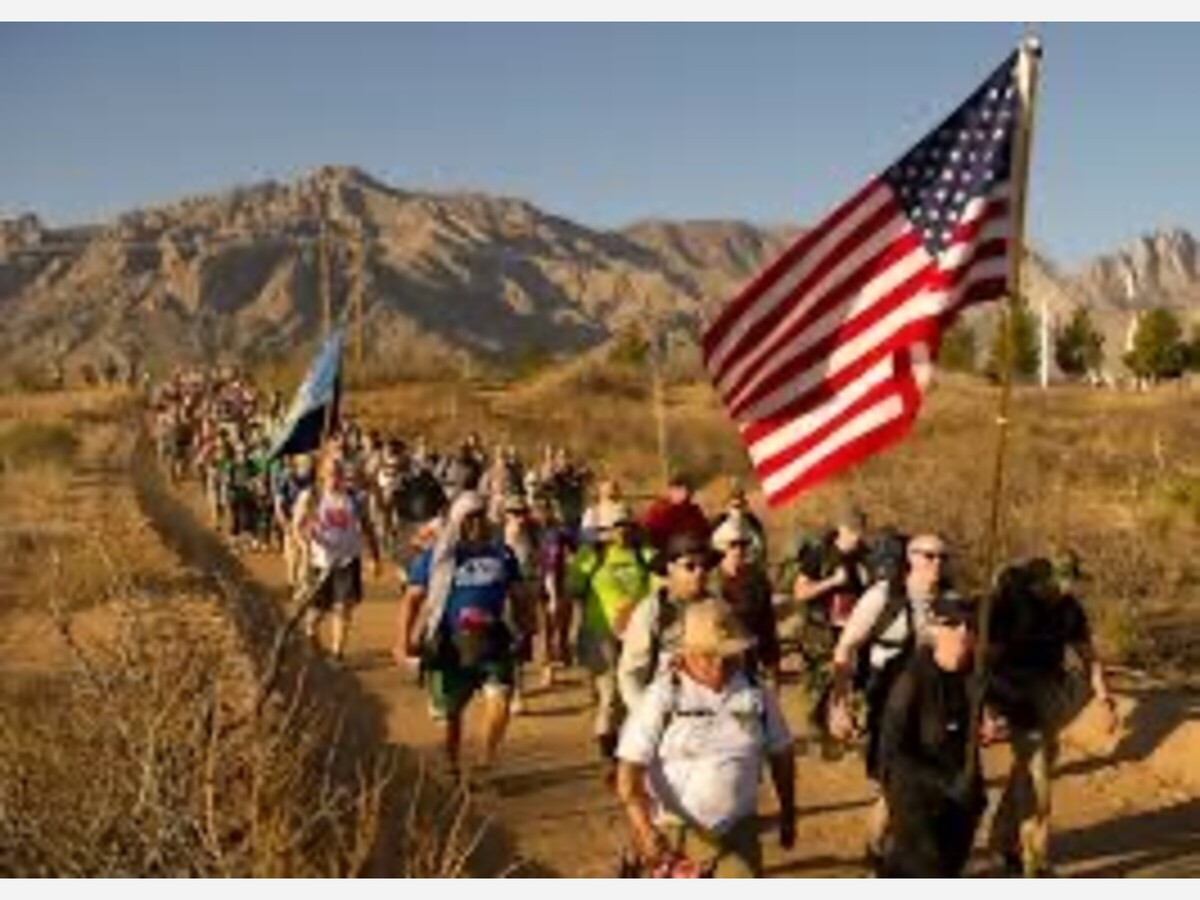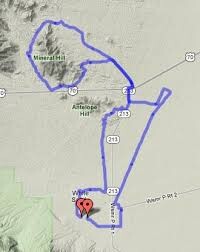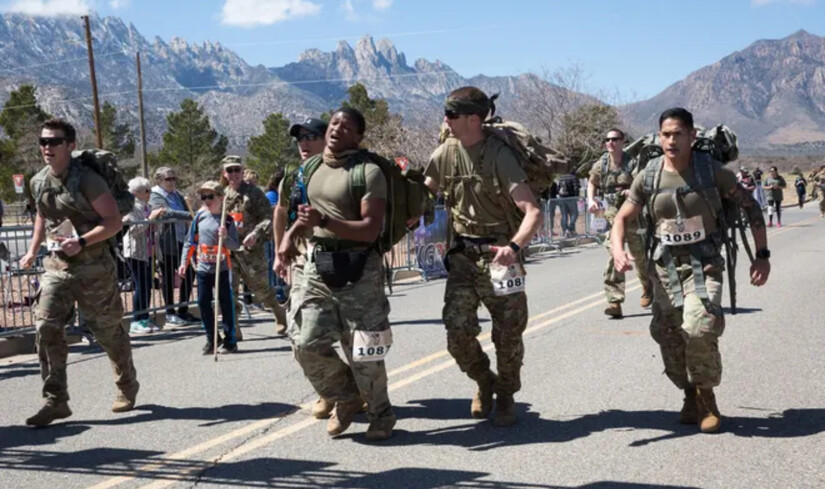Image


Those seeking a hotel this weekend or grabbing dinner at a restaurant may have noticed all rooms are full at the inn and longer than usual waits at the better restaurants in town. Many have asked why is it so busy?
This weekend White Sands Missile Range welcomes participants from around the nation and around the world to the Alamogordo Las Cruces region to participate in the Bataan Memorial Death March Marathon with 10,000 expected participants this year.
The Bataan Memorial Death March is an annual commemoration of the Bataan Death March attended by many of the survivors of the march, along with thousands of supporters from around the world, held at White Sands Missile Range, New Mexico. Held annually since 1989, this is a full marathon, or a 15 mi (24 km) route for those who do not wish to complete the full course. Covering paved road and sandy trails, it is regarded by Marathon Guide as one of the top 30 marathons in the U.S.

AlamogordoTownNews.com reporter, Chris Edwards met up with several visiting participants and asked them about their journey. David from New York staying at a local Alamogordo hotel explained his visit and participation, “this is my first marathon but I came to pay tribute to my grandfather who was a survivor of the actual Bataan death march.”
James Hampton of Arizona said, “I’m attending this year with my wife and we will fast pace walk the event, i competed a decade ago with a military team, we did well but it was fatiguing, the weather looks much nicer this year then that year as here was snow on the peaks that year.”
Several ROTC teams are staying at local hotels and competing we met up with some members of a team from California who is super excited to attend. A member spoke to us and said, “getting up at 3 am to be at the gate pumped and ready to go is our plan. We are going to pay honor but also our goal is to place in the top 10 teams. This is a unique experience and opportunity to visit this area for us.”
 ROTC units from around the nation join at White Sands
ROTC units from around the nation join at White Sands
Local participant Meike Schwarz posts and tells of her past experience and is participating again this year.
“The time has come: Bataan Memorial Death March. I am out there in the Desert with thousands of others to conquer 26.2 miles.Got my package and start number. Enjoyed conversations with lots of participants from all of the United States and of course picked up a lot of goodies. I love my T-Shirt I received. Walking to the descendant hall was again a very emotional experience. Seeing so many pictures of young men in uniform who never came home and reading some of the letters written to their families was just heartbreaking. I might not have any relatives who fought for the USA, but it is a privilege to join the march to honor the fallen and the ones who made it back home. Unfortunately, the last survivor passed away, but all of them left their stories with us.
And that I promise ... I will carry them with me in my heart and they will encourage me to make it to the finish line.” -Meike Schwarz of Welcome Home Realit
 Meike Schwarz of Welcome Home Reality styling before the Bataan Memorial Death March Marathon 2024
Meike Schwarz of Welcome Home Reality styling before the Bataan Memorial Death March Marathon 2024Marathon runners from around the nation come to compete. Locally,Coach Rene Sepulveda, retired Big 10 NCAA champion winning coach and owner of ReneFit New Mexico has participated and trains participants for the big day. For more than a decade he has trained individuals locally and via remote training programs he has developed to ensure individuals gain experience but have the strength and endurance to compete without injury to themselves. He says, “this event is unlike any other marathon in the United States as the course is strenuous and challenging, as such it can be unusually taxing on the body add the altitude to the mix compared with most marathons in the US and that adds to the complexity of the need for well balanced training in preparation for this hugely successful and important run.”
The race is open to all members of the public, though a significant portion of the participants are members of military units of the U.S. and foreign armed forces and their families. Civilians usually run in the full marathon, which is timed with awards though not certified by USA Track and Field. Several surviving Bataan prisoners usually await the competitors to congratulate them on completing the grueling march. Many injured veterans including some amputees attend to march as well.
The race continues all day, with the slowest marchers taking over 12 to 13 hours to complete the course.
There are two individual categories ("light" and "heavy") and one team category, and two divisions: civilian and military. In the light category, runners may wear standard distance-running apparel; in the heavy division they must carry a minimum of 35 lb (16 kg) in rucksacks or backpacks in addition to any consumables. Military entrants must wear their Army Combat Uniform (ACUs) or other service equivalent uniform.
A team must include exactly 5 people, and only finishes the race if all members finish together, on the principle that one does not leave teammates behind.
Paying Tribute:
During World War II, on April 9, 1942, 75,000 United States soldiers and Filipino soldiers were surrendered to Japanese forces after months of battling in extreme-climate conditions. The U.S. soldiers were from the multiple branches of the U.S. military: Army, Army Air Corps, Navy, and Marines. Among those seized were members of the 200th Coast Artillery, New Mexico National Guard.
Soon after the bombing of Pearl Harbor on December 7, 1941, Japanese forces began the invasion of the Philippines. The capture of the Philippines was crucial to the Japanese. It would bring them one step closer to the control of the Southwest Pacific. The Philippines were just as important to the U.S. Having troops in the Philippines gave the U.S. footing in the Southwest Pacific. After the invasion of the Philippines, U.S.-Filipino troops defended the crucial lands.
These brave soldiers were responsible for the defense of the islands of Luzon, Corregidor, and the harbor-defense forts of the Philippines. They fought in a malaria-infested region, and survived on little portions of food. Some lived off of half or quarter rations. The soldiers lacked medical attention. U.S. medics did what they could to help their fellow soldiers. They fought with outdated equipment and virtually no air power.
The soldiers retreated to the Philippine Peninsula when Japanese forces were reinforced and overwhelmed the U.S.-Filipino soldiers.
On April 9, 1942, the U.S. and Filipino soldiers surrendered after seven months of battle combined with exposure to the extreme elements, disease, and lack of vital supplies. The tens of thousands of U.S. and Filipino soldiers were forced to become prisoners of war to the Japanese. The soldiers faced horrifying conditions and treatment as POWs.
The soldiers were deprived of food, water, and medical attention, and were forced to march 65 miles to confinement camps throughout the Philippines.
The captive soldiers were marched for days, approximately 65 miles through the scorching jungles of the Philippines. Thousands died. Those who survived faced the hardships of prisoner of war camps and the brutality of their Japanese captors.
The POWs would not see freedom until 1945 when U.S.-Filipino forces recaptured the lost territory.
In 1945, U.S.-Filipino forces recaptured the Philippines and freed the captive soldiers who were suffering in the confinement camps. These soldiers would be impacted by the poor conditions of the camps and the mistreatment by their Japanese captors. About one-third of the prisoners died from health complications after they were freed.
Others were wounded or killed when unmarked enemy ships transporting prisoners of war to Japan were sunk by U.S. air and naval forces.
During the Bataan Death March, approximately 10,000 men died. Of these men, 1,000 were American and 9,000 were Filipino.
This had a huge impact on New Mexico families. Of the 1,816 200th and 515th Coast Artillery men identified, 829 men were to never return home, losing their lives in battle, in prisons, or after liberation.
World War II, the bloodiest war in history, claimed 60 million lives and ended on September 2, 1945.
The Army ROTC Department at New Mexico State University began sponsoring the Bataan Memorial Death March in 1989. The memorial march was to mark a page in history that included many native sons and affected many families in the state. In 1992, White Sands Missile Range and the New Mexico National Guard joined in the sponsorship and the event was moved to the White Sands Missile Range.
Since its inception, the Bataan Memorial Death March’s participation has grown from about 100 to about 9,600 marchers. These marchers come from across the United States and several foreign countries. While still primarily a military event, many civilians choose to participate in the challenging march. Participants get to choose between two courses: a 14.2-mile and a 26.2-mile course.
Marchers participate in the Bataan Memorial Death March for many reasons: personal challenge, the spirit of competition, or to foster esprit de corps in their unit. Some march in honor of a family member or a particular veteran who was in the Bataan Death March or who was taken as a prisoner of war by the Japanese in the Philippines.
The AlamogordoTownNews.com and KRAZY KALHRadio.org welcome the 2024 participants and celebrates their efforts and we pay tribute to the memory of those honored by this annual event.
